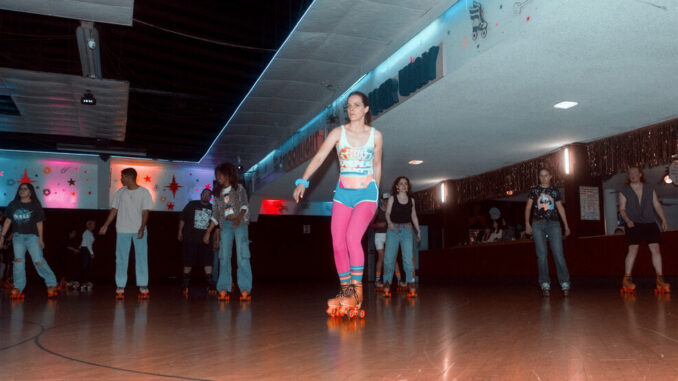
A companion to T’s 212 series about New York institutions, the 213 column highlights beloved landmarks in and around Los Angeles.
On a dark night in February, east of the 5 Freeway, south of the 134, down the street from the so-called Gentlemen’s Club, glows the blue neon sign: Moonlight Rollerway. These are the industrial hinterlands of Glendale, a tidy enclave in the rambling city-state that is Los Angeles, and here, among plumbing supply warehouses and an Amazon delivery van lot, sits a squat cinder-block building, an unexpected portal.
Under the white overhang, signage abounds: “No In & Out Privileges,” “No Fast Wild or Reckless Skating,” “Be Neat & Clean.” A lengthy passage politely, firmly reminds visitors that risk of accident is inherent in the sport. “If you are not willing to assume that risk,” it reads, “please do not roller-skate here.”
Risk assumed, the 30-some customers ahead of me move steadily up the cement ramp to the box office and flash their tickets for the clerk behind the window. Those who’ve brought their own skates — about half the crowd — present them for inspection (no fiberglass wheels, no micro wheels; they can gouge the floor). Then a door slams behind us and we are somewhere else, in the land of motion.
Nostalgia comes fast, from all directions — the black carpet patterned with fluorescent zigzags, the buzz and trill of a Ms. Pacman game, a whiff of some sugary confection being heated at the snack bar — but most of all from the rink, where, beneath two disco balls, skaters revolve, some gliding, some wobbling, one pressing herself against the red-carpeted wall while Donna Summers asks, “Could it be magic?”
“We want you to walk in and feel like it takes you back to whatever era you remember,” says Adrienne Van Houten, the rink’s manager. “This is my 1973, ’74. For my kids, it’s the ’90s.”
For me, it’s 1983, and I am propelled into a piercingly vivid flashback of a childhood birthday party, skating to Taco’s “Puttin’ on the Ritz.”
For Jack Cardinal, a software developer and rink regular, it’s not about traveling to the past but to the present. “You have no other choice,” he says. “If you have stories going on in your head about work, about money, whatever, all of those will be put on hold for a couple of hours.” Cardinal started coming years ago when his doctor told him to find a form of cardio that he loves.
Dominic Cangelosi bought the rink in 1985. He’d been working there as an organist for nearly 30 years. The building was erected in 1942 for a much different purpose — it was designed as a foundry to manufacture airplane parts during World War II — before it was converted into Harry’s Roller Rink in the 1950s and rechristened the Moonlight Rollerway in 1969 by the then-owners Cliff and Mildred Neschke. When they retired, Cangelosi took the reins, and he’s since ushered the roller way into the pantheon of hallowed Los Angeles institutions, like Musso and Franks, the Bob Baker Marionette Theater and the Apple Pan.
Cangelosi started a Rainbow Night, one of the first L.G.B.T.Q.-themed skate events in the country in 1985, and it’s still one of the busiest times of the week. He hosted artistic skating competitions with teams coming from all over the world, and countless birthday parties. For over 60 years, he accompanied skaters on his electric organ, serenading them with waltzes, polkas, fox trots and cha-chas, but then the pandemic shuttered the roller way in 2020. When it reopened 14 months later, many of the old-timers who’d come for the live music didn’t return. Cangelosi, now in his 90s, retired from the keyboard, but not the rink. When he’s not there in person, he watches the action from live-cam monitors in his home.
We live in the endless scroll of our screens, but here on the floor — two and a quarter inches of maple wood, all tongue-and-groove boards, nary a nail — that’s simply not possible. Another rule: no hoodies. That’s so the floor guards in striped referee jerseys, expertly weaving through the swirling crowd, can make sure people aren’t wearing earbuds. If skaters aren’t listening to the same music, collisions are inevitable.
“We can give you ice packs and call an ambulance,” Van Houten says, but the staff isn’t legally allowed to provide medical assistance.
No one seems to protest the hoodie rule. Everybody is clearly happy in the collective groove — most people are beaming when they bring their skates back to the rental counter.
“That’s because the adrenaline is still going,” Van Houten says with a laugh. “The pain in their quads hasn’t set in.”


Be the first to comment